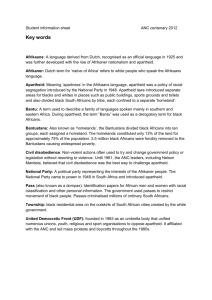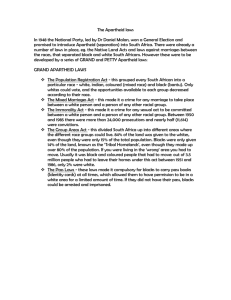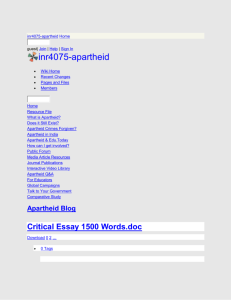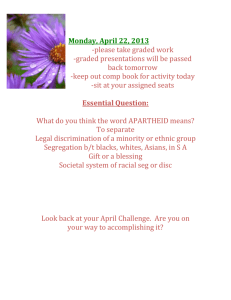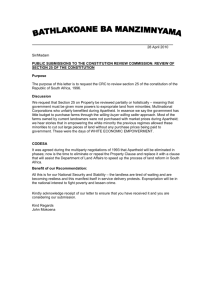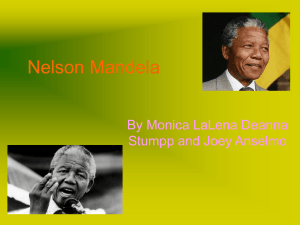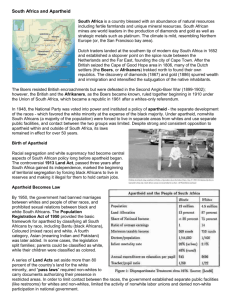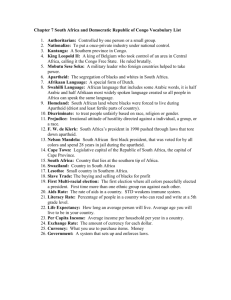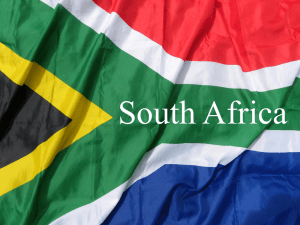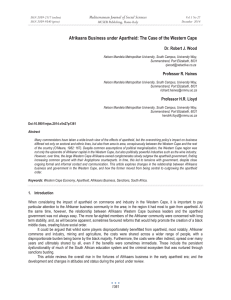Would you have chosen your name for yourself?
advertisement
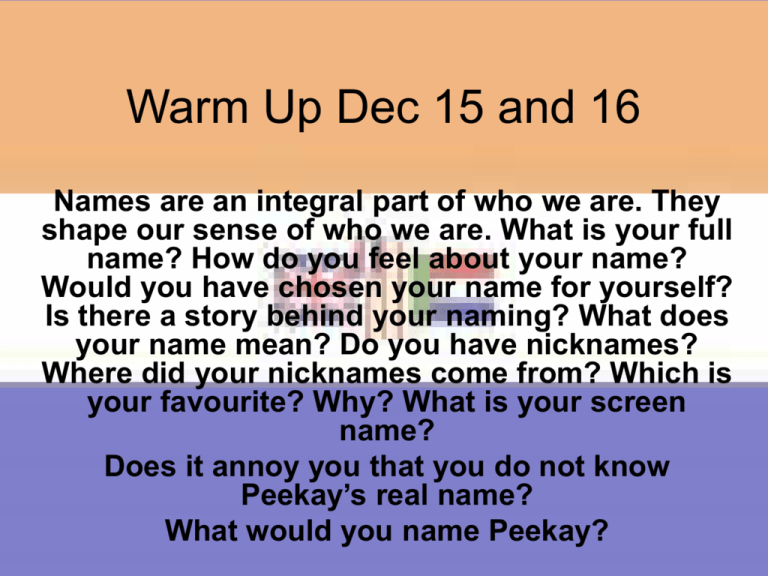
Warm Up Dec 15 and 16 Names are an integral part of who we are. They shape our sense of who we are. What is your full name? How do you feel about your name? Would you have chosen your name for yourself? Is there a story behind your naming? What does your name mean? Do you have nicknames? Where did your nicknames come from? Which is your favourite? Why? What is your screen name? Does it annoy you that you do not know Peekay’s real name? What would you name Peekay? Peekay as a hero • The Hero’s journey – Chart – Peekay’s place as a hero Apartheid in South Africa What is Apartheid • The process of segregation that happened in South Africa. It became law in 1948. • The Afrikaans word for “Separateness“ • Included racial, political, and economic segregation of non-European peoples The Afrikaner Nationalist approach • Afrikaner Nationalists believed in the superiority of the Afrikaner nation. • Believed that their identity was God given. Feared that the Afrikaner’s existence was threatened by the mass of Africans in South Africa • Feared the Afrikaner nation would be swamped and overcome if there was mixing of the races. • Afrikaner Nationalist historians explain apartheid as the consolidation of these beliefs through a range of laws that were passed to prevent the mixing of the races and to preserve this “God-given” Afrikaner identity. Group Areas Act • (Act No. 41 of 1950) was an act of parliament created under the apartheid government of South Africa that assigned races to different residential and business sections in urban areas in a system of urban apartheid. • Effect of law excluded any non-white from being allowed to live in established towns or to live and work in any established economically viable areas - all of which were proclaimed to be White areas. • Caused many non-Whites to have to commute large distances from their homes in order to be able to work. Reservation of Separate Amenities Act • (Act No 49 of 1953), formed part of the apartheid system of racial segregation in South Africa. • The Act enforced segregation of all public facilities, including buildings, and transport, in order to limit contact between the different races in South Africa. The Act also stated that the facilities for different races did not need to be equal, and in practice, the best facilities were reserved for whites while those for other races were inferior. Other Acts • Prohibition of Mixed Marriages Act 1949 • Immorality Act (1950-1985) It forbid all sexual relations between whites and nonwhites Pass Laws • Made it compulsory for all black South Africans over the age of 15 to carry a "pass book" at all times. The law stipulated where, when, and for how long a person could remain. This pass was also known as a dompas. • The document was similar to an internal passport, containing details on the bearer such as their fingerprints, photograph, the name of his/her employer, his/her address, how long the bearer had been employed, as well as other identification information. Employers often entered a behavioural evaluation, on the conduct of the pass holder. Civil Disobedience • “Open the jail doors, we want to enter!” The Defiance Campaign In 1952 the African National Congress launched the Defiance Campaign. A programme of civil disobedience was planned. This meant that large groups of Africans would act peacefully but would deliberately break the law. They aimed to get arrested and flood the country’s prisons. They hoped that this would draw public attention to the apartheid laws and force the government to abolish them. Mass rallies were held throughout the country. From here, groups of volunteers were sent to break the law. They walked through ‘whites only’ entrances, sat in parks set aside for whites only, broke curfew, and refused to carry their passes. As a result, over 8 000 people were arrested. The campaign had an enormous impact on the people and ANC membership swelled from 7 000 to 100 000. However, the police responded with extreme violence, especially in the Eastern Cape, imposing heavy fines and even jail sentences, and the ANC was forced to call off the campaign. Inequality • More than eighty percent of South Africa’s land was set aside for its white residents, despite the fact that they comprised less than ten percent of the population. South Africa’s black majority had resisted apartheid for many years. They began rioting in 1976, when the South African government tried to force black children in the Soweto township to learn Afrikaans, one of the languages of the white minority. The rioting continued for the next fourteen years until the apartheid laws were repealed. Soweto Uprising • On 16 June 1976, 20 000 students marched through Soweto in protest against the use of Afrikaans in schools. • • • • • • • • Population:1.5 million Area:87 km square Hot water:5% homes Hospitals:1 Schools:280 Number of pupils per class:60 Average income per month:R100 Average cost of living per month:R140 Nelson Mandela • “To be free is not merely to cast off one’s chains but to live in a way that respects and enhances the freedom of others”.
